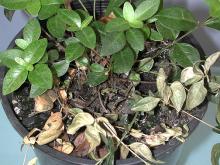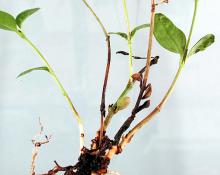Cause Both Phoma sp. and Phomopsis sp. have been described on vinca. The two fungi are very similar in cultural and some disease characteristics. They are favored by high soil moisture and frequent overhead irrigation.
Symptoms Shoot tips become dark brown, wilt, and die back to the soil surface. Some affected stems are nearly black.
Cultural control
- Remove and destroy infected plants or plant parts.
- Avoid overhead irrigation or apply such that plants are not wet for extended periods of time.
Chemical control A combination of thiophanate-methyl (Group 1 fungicides) and mancozeb (Group M3 fungicides) has been effective in the Southeast United States.
- Nu-Cop 50 DF at 1 lb/100 gal water. Group M1 fungicide. 48-hr reentry.
- Orkestra at 8 to 10 fl oz/100 gal water. Group 7 + 11 fungicide. 12-hr reentry.
- Pageant at 8 to 12 oz/100 gal water. Do not use with organosilicone-based adjuvants. Group 7 + 11 fungicide. 12-hr reentry.
- Protect DF at 1 to 2 lb/100 gal water plus 2 to 4 oz spreader-sticker. Group M3 fungicide. 24-hr reentry.
- Spectro 90 WDG at 2 lb/100 gal water. Group 1 + M5 fungicide. 12-hr reentry.
- Thiophanate-methyl-based products have been shown to be safe on periwinkle and may have activity on stem blight caused by Phoma. Group 1 fungicide. 12-hr reentry.
- Cleary's 3336 EG at 16 to 24 oz/100 gal water.
- OHP 6672 4.5 F at 14.5 to 20 fl oz/100 gal water.
Reference Pecknold, P.C. 1980. Evaluation of fungicides for control of stem blight of periwinkle. Fungicide and Nematicide Test Results 35:140.



